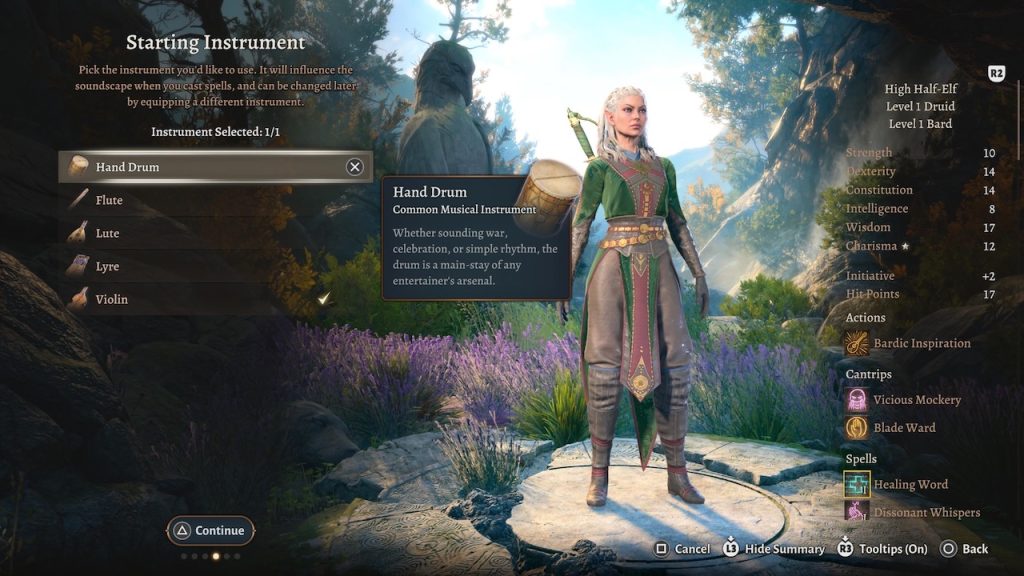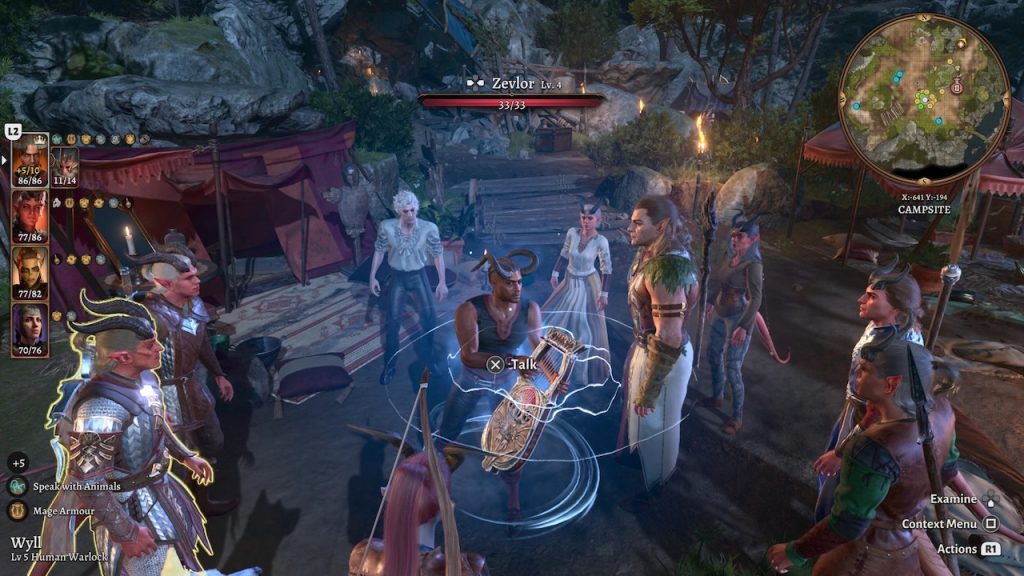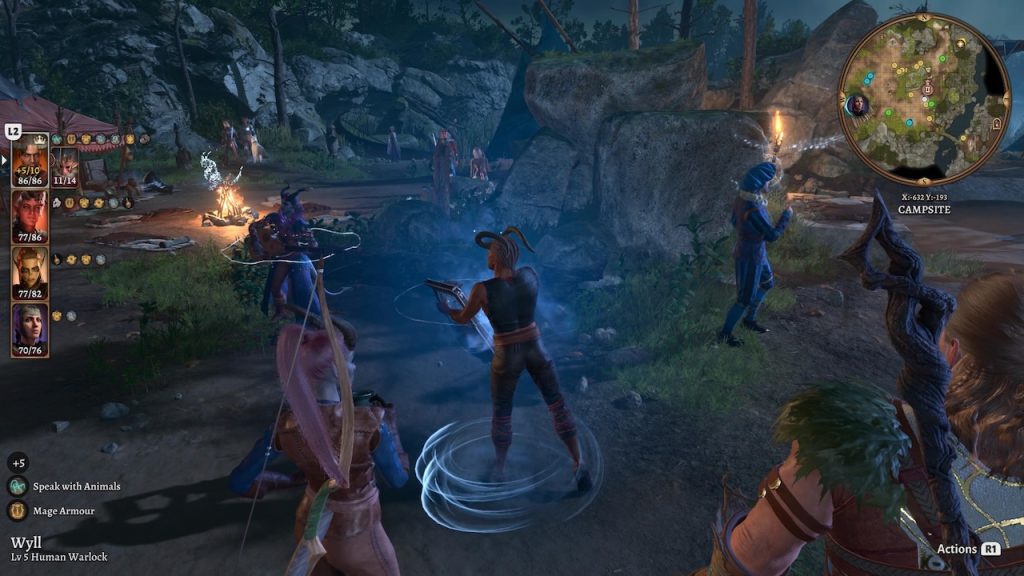CW: There are videos in this post that include rapid movement in a video game. If you have vertigo or a similar reaction to visual media, the videos may be disorienting. Since this essay is about the audio, you can close your eyes or look away while the videos play and still understand what’s going on.
TL;DR: You can lay down audio tracks within Baldur’s Gate 3.
For those not familiar with Dungeons and Dragons, a “Bard” is a type of character you can play. They embody the tropes of the magical singer, storyteller, and troubadour that are found in fantasy fiction.
In BG3, there’s only one Bard character who actually sings: Alfira.

For both technical and practical reasons, with that one exception the Bard characters in BG3 don’t sing. The main distinguishing feature of a Bard is that they play a musical instrument. If you see a Bard entertaining a crowd, they’ll be playing a tune.
When you create a Bard character, you have a choice of which instrument you’ll start with:

Any instrument you find will be one of those five types; e.g., there may be a magical flute, but it will still be a flute. There’s one more “instrument” that’s not in the list: If you have the skill “Musical Instrument”, you try to play a song, and you’re not actually holding an instrument, then you’ll whistle.
Once you have the Musical Instrument skill, you can play any instrument you find in the game. You’re not limited to the one you start with.
This is the typical experience of playing an instrument in the game.
In playthrough 11, Karlach is not a Bard, but she picked up the Musical Instrument skill from a special encounter.
In the video, you can see the game’s typical response to playing an instrument:
- Nearby non-player characters (NPCs) will gather around you. This can be handy; while your Bard is distracting a crowd, your Rogue can be looting and pickpocketing.
- There will be a check to see how well you’ve played; in the video you might catch the words “Performance Failed”. If the Performance had succeeded, members of the crowd would have tossed gold coins on the ground. There’s an achievement for gathering a total of 100 coins from performances, but I haven’t tried to earn it.
- You’ll continue to play music until your character does something else, like move.
Let’s focus on that last point. If you listened to the video above, the sound was pleasant enough, but I found it to be “shapeless”. (If you haven’t figured out yet that I don’t know much about music, that statement just confirmed it.)
You have a choice of six different songs you can play.

Six songs, and six different instruments (including whistling). Thirty-six combinations… and they all sounded bland to me. Why?
I got my first clue when I played Wyll as a Bardlock (part Bard, part Warlock) in playthrough 8. He played his instrument at a party:

I noticed that when I had him play his lyre near a couple of other NPC Bard characters at the party, they automatically started playing along with him:

I’m still in the midst of playthrough 11. As it happens, I have one character who’s a Bard, and Karlach has the Musical Instrument skill. With two musicians, I could experiment.
Here we see Karlach on the violin and Astarion whistling next to an NPC Bard on the lyre, while Minthara the Green Witch listens in the middle. I’m only showing a few seconds to give you an idea; you’ll see a full-length performance in the videos below.
Finally, it became clear to me: Each instrument was playing a single track from an ensemble performance of the song I selected.
I had to put the band back together!
Without further ado, it’s my pleasure to introduce to you the Undecimo Ludo Ensemble:
- On the lyre, Karlach the Barbarian
- On the drums, Wyll, Blade of the Frontiers
- On the flute, Gale, Wizard of Waterdeep
- On the lute, Minthara the Green Witch
- On the violin, Shadowheart the Heretic Cleric
- The conductor and whistler, Astarion the Pale Assassin
- And their roadie, Scratch the Good Boy
For their first performance, we have “The Queen’s High Seas”:
Next, we have “Sing For Me”:
From the streets of the Circus of Last Days to the stage, they perform “The Power”:
We move to the graveyard behind the Open Hand Temple for the classic song “Of Divinity and Sin”:
Now we have a rooftop performance of “Old Time Battles”:
The tour ended in front of a really tough crowd in Wyrm’s Rock Fortress. They didn’t even wake up for “Bard Dance”!
Credits
Music
First, I must acknowledge that you can hear better-quality versions of some of these songs on the Baldur’s Gate 3 soundtrack album. Here are links to the Youtube videos of the respective songs:
All of the music in BG3 was composed by the talented Borislav Slavov.
Band
It’s almost impossible to get all six instruments to play at once within the main game. The problem with playing the instruments in camp is that as you shift focus from one party member to another, the previous party member will walk back to their home tent; any movement at all will cancel their performance. In the main adventure, even if you have all four of your party members with the Musical Instrument skill, you’d need a spot with two NPC Bards within earshot of each other; I don’t think there is such a location.
However, the folks at Larian Studios have permitted their player population to create mods for BG3. I’ll have more to say about mods when I do my write-up of playthrough 11. For now, I’ll just say that I used the following mods to create the videos:
- Adjustable Party Limit allows you to have more than the standard four members in an adventuring party. As you might be able to tell from the above videos, this let me set up my six-piece orchestra.
- A band is nothing without its costumes. If you see an outfit that’s non-standard to you, it came from FearTaylor’s Camp Clothes.
- Faerun Colors gave me a large palette of dyes for the outfits.
- You can’t have a Witch without the Witch Class mod. Of course, Minthara didn’t use any of her powers during the performances… this time.
Performance
In most of the videos, I make a fuss about adding each instrument to the performance one-by-one. The fact that all the sounds slide together smoothly and form a unified whole is due to the talents of the audio team at Larian Studios.
Of all the optional things one might add to a role-playing video game, audio work like this must seem the most optional. I’m far from the first to discover how the thirty-six combinations of instruments and songs work together, but I’m glad it was there to discover.
On the other hand, if you found the sound balance in the videos to be lacking (e.g., why is Gale’s flute too loud?), that’s my fault. The relative volumes of the instruments are related to position of the camera. In most of the videos, that has to do with how I positioned Scratch.
Special Guest Encore
I’ll wrap this up with the one true Bard performance in Baldur’s Gate 3 from its one True Bard, Alfira. (The real-world singer is Ilona Ivanova.)
Thanks, Alfira. I’m sorry I killed you in playthrough 11.
(No, it’s not a Dark Urge playthrough! More to come…)
Pingback: BG3 – Barding it 2: Electric Boogaloo – The Argothald Journal
Pingback: Baldur’s Gate 3 – Playthrough 11 – Zapper Disaster – The Argothald Journal
Pingback: Baldur’s Gate 3 – Playthrough 12 – Bits and Pieces and Nudity – The Argothald Journal
Pingback: Baldur’s Gate 3 – Playthrough 1/14 – Problems and Plans – The Argothald Journal
Pingback: Baldur’s Gate 3 – Playthrough 2/14.5 – Raelia and Tavelle – The Argothald Journal